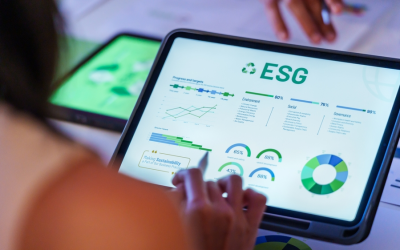Reducing ESG Disclosure Efforts with AI: Streamlining BRSR, CSRD, GRI & EcoVadis Compliance
McKinsey’s 2024 survey shows that 65 percent of organizations now use generative AI regularly. That’s almost double the adoption rate from the previous year.
This surge shows that AI for ESG is no longer experimental. It’s becoming a core driver of efficiency and accuracy in business functions, including ESG reporting. The integration of ESG AI technologies and ESG Analytics AI is changing how organizations approach sustainability disclosures.
The United Nations’ 2025 STI Forum highlights this trend. AI now plays a key role in strengthening early warning systems. It also improves the accuracy and timeliness of ESG-related data. For companies under increasing scrutiny, reliable and timely ESG disclosure is no longer optional. It’s now critical to maintaining credibility and meeting ESG compliance obligations.
In India, the urgency is clear. Since SEBI introduced Business Responsibility and Sustainability Reporting (BRSR) in 2021, the top 1,000 listed companies must disclose detailed sustainability performance. Understanding what is ESG disclosure and how it relates to the BRSR Framework is essential for companies navigating these requirements. When layered with global ESG disclosure frameworks such as GRI, CSRD, and IFRS, the burden of compliance grows year after year.
The question of which pillar of ESG do transparency and disclosure come under is crucial. These elements fall primarily under governance. They emphasize accountability and stakeholder communication. The result? Reporting fatigue. ESG teams are buried in repetitive, manual tasks just to keep pace with disclosure requirements. In this environment, automating ESG disclosure and reporting with AI tools offers a way forward. It enables faster, framework-aligned reporting.
Why ESG Reporting Feels Overwhelming
Most frameworks ask for the same data points, just packaged differently. This includes BRSR compliance requirements in India, CSRD compliance in Europe, and global standards like GRI Reporting and ESRS.
Managers often spend weeks pulling this data together. They spend late nights reconciling spreadsheets. They dig through legacy systems. They email suppliers for Scope 3 data. And they still worry: “Is this accurate? Will it pass audit checks?”
The ESRS framework initial drafts alone include 100+ reporting requirements and nearly 700 KPIs.
Instead of building insights and driving strategy, managers spend countless hours copy-pasting information into different templates. The outcome? Reporting becomes a drain instead of a driver. This is where AI solutions for sustainability reporting frameworks become invaluable.
Common Roadblocks in ESG Reporting
Teams face recurring hurdles that slow down reporting and weaken credibility:
-
Inefficient reporting methods – Same data entered multiple times
-
Inconsistent data – Numbers vary across files and departments
-
Overlapping frameworks – BRSR, CSRD, GRI, ESRS often ask for the same metrics in slightly different formats
-
Siloed teams – Little collaboration or visibility across departments
-
Audit challenges – Scattered evidence, missing trails
-
Weak narratives – Struggling to explain the story behind the numbers
Unlike financial reporting, ESG disclosures are still evolving. Processes are fragmented. The lack of established frameworks makes it harder to ensure credibility. Companies must gather reliable data from suppliers and partners. Many organizations also wonder what EcoVadis is and how to prepare for EcoVadis assessments while managing other reporting requirements. Add the complexity of Scope 3 emissions, and the challenge multiplies.
By some estimates, ESG reporting involves over 1,000 discrete measures. With fragmented processes and complex Scope 3 data, credibility is hard to maintain.
How AI Reduces the Time and Cost of Disclosure Readiness Across Frameworks
Reducing manual ESG reporting efforts with AI automation delivers tangible benefits of AI in ESG compliance and sustainability reporting:
1. Automated Data Extraction & Analysis
With AI-powered tools, the tedious task of manually combing through files disappears. AI can swiftly review hundreds of documents, invoices, and spreadsheets. It extracts accurate, disclosure-ready insights. The result? Reduced manual effort, faster analysis, and more time for teams to focus on strategic work. Snowkap AI enables this at scale.
2. One Source of Truth for ESG Data
ESG AI minimizes inconsistencies. It consolidates information into a central, reliable repository. All stakeholders work from the same dataset. This reduces errors and improves confidence. Snowkap’s platform helps unify and structure this data seamlessly.
3. Framework-Aligned Reporting at Scale
Data points like Scope 1 emissions often need disclosure in multiple formats. This applies to BRSR compliance, CSRD compliance, GRI compliance, and IFRS.
For example:
BRSR: “Provide details of Scope 1 GHG emissions (direct emissions from owned/controlled sources).”
GRI 305-1: “Report gross direct (Scope 1) GHG emissions in metric tons of CO₂ equivalent.”
CSRD (ESRS E1-6): “Disclose gross Scope 1 GHG emissions, broken down by sectoral activity if relevant.”
IFRS S2: “Disclose Scope 1 GHG emissions, in CO₂e, for the reporting period.”
Even though they ask for the same datapoint, the formatting and wording differ. At Snowkap, we automate this mapping and reuse through our esg reporting software. Once the data is collected, it can be repurposed across all frameworks. No manual duplication needed. This frees teams from repetitive reporting tasks.
4. Audit-Ready Data Libraries
AI for ESG creates structured, searchable data libraries. Information is always accessible when compliance checks or audits arise. This improves readiness and reduces last-minute stress.
AI not only prepares disclosures but also links them back to original data sources. This ensures smoother and more reliable audits. Snowkap supports teams by keeping ESG data organized and audit-ready.
5. Stronger, Automated ESG Narratives
ESG analytics AI uses previously collected data to generate consistent, tailored responses. These work for reports and disclosures. This strengthens the esg disclosure narrative while reducing time spent drafting. Snowkap helps make every disclosure more credible and complete.
From Fatigue to Impact
The demand for credible esg disclosure will only intensify. KPMG’s 2023 CEO Outlook report shows that 79% of the N100 group already report on sustainability. (The N100 includes the leading 100 companies per country.)
Companies relying on manual, fragmented processes will fall behind. Those that adopt AI-driven esg reporting will:
- Earn stakeholder confidence
- Build audit resilience
- Free up time for actual sustainability impact
“AI and ESG are reshaping the world around us. Success will be defined by those who navigate these two trends with intent, scale, and speed.”
Unlock Smarter ESG Reporting with AI
Stop letting repetitive disclosure tasks slow you down. With Snowkap’s AI-powered platform, you can streamline BRSR, CSRD, GRI, and EcoVadis reporting. Ensure audit-ready data and focus on driving real sustainability impact.
Explore how Snowkap can transform your ESG reporting.



